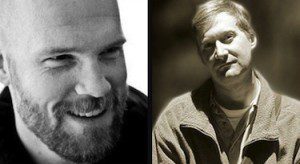There is a moment after a movie as the credits roll, when the feelings, memories, and ideas that the movie inspired have not yet been put into words. With really great films a sensation lingers, an emotional response that is the mark of great storytelling. JM Tyree and Michael McGriff have captured this feeling in a love letter to filmmaking with their wondrous collection of short stories, Our Secret Life in the Movies.
San Francisco film buffs McGriff and Tyree set out to watch all 800 + films in the Criterion Collection in a single year. By any standard the project is ambitious: two or three films a day. In an interview with The Paris Review the authors say they were inspired by the location of their shared apartment: “We were living in that wonderful place near Mission Dolores, a block away from where Alfred Hitchcock created the fictional grave of Carlotta Valdes in Vertigo…” Soon after, they began writing stories. “We started writing these pairs of stories. For each movie that fascinated us, we’d both write one story. A double take on the film.” Our Secret Life in the Movies was born.
The book is structured with two pieces of flash fiction following a single movie title. The stories are fictionalized accounts of the writers’ childhoods, subtle and somber portrayals of boys coming of age in the eighties. “For our ninth birthdays, Dwayne got a ticket to Space Camp and I got a set of fatigues and an Amtrak ticket to visit Ron O’ Farrell, my dad’s Vietnam buddy who ran a hunting service in Wyoming.” None of the stories are given bylines—readers won’t know whether McGriff or Tyree wrote the piece—but identifying clues seep through. Anyone who grew up in the eighties will quickly feel at home with themes like Reganomics, the arms race, and Cold War commentary, but the focus remains on the emotional energy of the time and the way the narrators view the world. “Everyone was frothing at the mouth for Reagan, and I slept comfortably in the arms of his speeches, beating my tin drum and hoping the Communists would stick their toes over the line.”

The stories are arranged chronologically, from youth to adulthood, and as the narrators age the stories become more experimental: a Barthleme-inspired piece composed of almost entirely questions, a father who takes an egg for a wife, a story in which the narrator apologizes for the case of ears he keeps under the bed. In the book’s final story, “Godzilla,” written after The Sacrifice by Andrei Tarkovsky, the narrator says: “I should probably tell you that my son is invisible. Other people can’t see him standing there by my side in the tourist photo from the Twin Towers, and nobody but me heard him speak in the exhibition… I wouldn’t say that he’s an imaginary boy, but it is true that he doesn’t seem to age.” These later stories reflect a more metaphorical view of the world, while remaining true to the wonder and imagination depicted in earlier pieces.
McGriff and Tyree have taken cues from the films to inspire, enhance, and develop their narratives. Very few people know the full Criterion library, and of the thirty-nine referenced in this book, non-movie-buffs will likely recognize only a few: Donnie Darko, Miami Vice, Jesus’ Son, Blade Runner, and a handful of others. But Our Secret Life in the Movies is incredibly approachable. The collection is slim (just over 150 pages, with some of the stories as short as a paragraph) and it does not rely on an intimate knowledge of the films. Still, the films provide the magic of the book. Reading the stories with the movies in mind, the narratives grow; they take on new meaning and depth. It is a true multi-media project, and one that is entirely unique.
Sometimes the connection between the films and the stories isn’t decipherable, but there is a bit of a game in discovering them. In “No Outlet,” a piece written after Morvern Callar, a British film about a woman who places her name on her dead boyfriend’s novel and then pitches it to publishing houses, the first line reads: “In the ninth grade, I was rewarded for plagiarizing a short story with a twist ending and kept on writing.” In, “Crockett & Tubbs” written after Miami Vice, the line “Drug murders on television took place in a neon neverland of speedboats and fast cars…” suggests a loss of innocence taking place in the narrative, but it is also a clear reference to the film. Other connections are less literal. In “Concordat” written after the documentary Burden of Dreams, which takes place in a notoriously difficult South American jungle, boys on a Young Life retreat to the woods in Northern California to do God’s work. And in “The Hill,” the second story inspired by Burden of Dreams, the narrator is in a wild backyard working manual labor for a family friend.
I would encourage readers to look up the movies and take advantage of the incredible value in this project. The quiet presence these films take in the stories conveys the idea that what we read, see, and hear outside of literature contributes to our own memories and storytelling. McGriff and Tyree have fused together two separate histories with a common voice, tone, and inspiration. This little book is a powerhouse of flash fiction, with each story standing alone in its remarkability. That it is so cohesive is extremely impressive. I am reminded of the Edmund Wilson quote: “No two persons ever read the same book.” A piece of storytelling resonates within each of us in a unique way. But perhaps McGriff and Tyree put it best in their introduction when they write: “We are in the movies and the movies are in us.”




